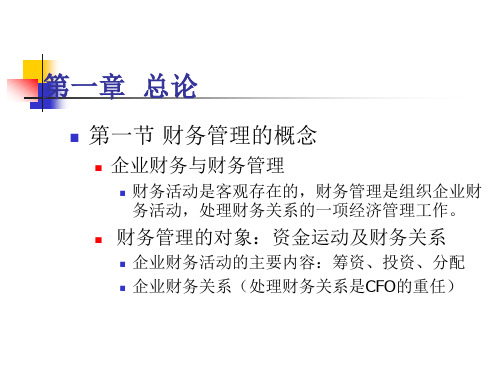财务管理基础培训课件(ppt 39张)
财务管理基础培训(ppt 93页)

不同时间的资金之所以不能直接对比,关键在于货币具有 时间价值,也就是货币的价值会随着时间的推移而发生变 化。原因如下。
(1) 投资收益的存在
当前的一笔资金能够立即用来投资并带来收益,而将来才 可获得的资金无法用于当前的投资,也无法获取相应的收 益,从而现在的一笔资金比将来的一笔同样数额的资金更 值钱。
例如,某人在银行存入1000元钱,在银行利率 12%的情况下,一年后可得到1120元。从绝对额 上看,1000元与1120元不等,但在货币时间价值 条件下,可以说一年后的1120元与今天的1000元 相等,或者说今天的1000元与一年后的1120元相 等。这就是货币等值的直观解释。
2.1.1.1.2货币等值的概念
2.1.1.1.2货币等值的概念
在进行上述分析的过程中可以看出,影响资 金等值的因素主要有三个:一是利率的高低 ;二是时间的长短;三是金额的大小。根据 这三个因素,就能确定不同时间的不同数量 金额是否等值。
2.1.1.Байду номын сангаас.3货币时间价值的计算基础
在利润平均化规律的影响下,等量货币资本 在相同时间内应获得等量利润。从这个意义 上看,货币时间价值的相对量形式就是在不 考虑风险和通货膨胀条件下社会平均的资本 利润率。由于货币时间价值的计算方法与利 息的计算方法相同,很容易将货币时间价值 与利息率相混淆。但通行的利息率中通常都 包括一定的风险价值和通货膨胀因素。
G,——产出资金;
G——资金增值部分,也就是货币的时间价值。
所以,简单地说,货币的时间价值就是资金随着 时间的推移而产生的增值部分。
2.1.1.1.2货币等值的概念
在货币时间价值的计算中,等值是一个十分重要 的概念。
《财务管理基础学习》课件

利润表
反映企业在一定会计期间 的经营成果,包括收入、 费用和利润。
现金流量表
反映企业一定时期内现金 流入和流出的状况。
财务分析方法
比率分析法
通过比较不同会计期间或 同行业之间的财务比率, 来分析企业的财务状况和 经营成果。
趋势分析法
业整体的影响。
转移策略
通过购买保险、外包等方式, 将财务风险转移给其他机构或
个人。
2023
PART 05
财务控制与审计
REPORTING
内部控制的重要性
1 2
保证财务信息的真实性和完整性
有效的内部控制系统可以防止财务欺诈和舞弊行 为,确保财务信息的准确性和可靠性。
提升企业经营效率
健全的内部控制制度可以帮助企业优化内部流程 ,提高经营效率,降低不必要的成本和风险。
财务预算的编制流程
财务预算的编制通常包括目标确定、预算计划、预算执行和预算调 整等步骤。
财务预算的编制方法
常见的财务预算编制方法有固定预算、弹性预算、滚动预算和零基 预算等。
投资决策的方法
投资决策的考虑因素
01
投资决策需要考虑的因素包括投资回报率、风险评估、资金成
本和项目可行性等。
投资决策的方法
02
财务合规与法规遵循
合规性要求
确保企业的财务活动符合相关法律法规、行业标准和监管要求。
法规遵循策略
制定并执行符合法律法规的财务管理策略,降低企业面临的法律风 险。
合规性审查
定期进行财务合规性审查,及时发现并纠正不合规行为,确保企业 持续合规经营。
2023
PART 06
财务管理基础ppt课件

内含报酬率法
通过计算投资项目的内含 报酬率来评估其经济价值 ,反映了投资项目的实际 收益水平。
投资风险分析
定量分析
通过定量模型和指标来评 估投资项目的风险,如波 动率、beta系数等。
定性分析
通过专家意见、行业趋势 等定性因素来评估投资项 目的风险。
风险管理措施
针对不同类型的风险,采 取相应的风险管理措施, 如对冲、保险等。
财务管理的本质:是对资金流的管理,即对企事业单位资金来源和运用进行计划、组织、监 督和控制。
财务管理的特点:系统性、综合性、复杂性。
财务管理的目标
经济效益最大化
这是财务管理的最基本目标, 即通过有效的财务管理,实现 企事业单位经济效益的最大化
。
风险控制
在实现经济效益最大化的同时 ,财务管理还需要有效控制风 险,保证企事业单位的稳定发 展。
复式记账
复式记账是一种会计记账方法,要求对每一笔经济业务进行双重记录,即同时 在两个或多个账户中进行登记,以便相互验证和核对。这种记账方法可以更准 确地反映企业的财务状况和经营业绩。
会计凭证与会计账簿
会计凭证
会计凭证是证明经济业务活动发生和变化的书面证明文件。每一张凭证都包含了 有关特定经济业务的信息,如交易日期、交易内容、金额等。
会计科目
会计科目是会计要素的具体分类,是财务报表中使用的标签 。例如,资产可以分为现金、应收账款、固定资产等科目, 负债可以分为应付账款、短期借款、长期债务等科目。
会计账户与复式记账
会计账户
会计账户是用于记录经济业务活动的分类账簿。每个账户都有特定的名称、借 方和贷方,用于记录经济事项的发生和变化。
投资组合优化
资产配置
根据投资目标和风险承受能力,合理配置不同类型的资产,如股 票、债券、现金等。
财务管理培训(最终版)ppt

通过不断改进预算管理流程和 方法,提高预算管理水平,为
企业发展提供有力支持。
04
投资决策与管理
投资决策的原则与流程
原则
风险与收益的平衡、长期投资、 多元化投资、谨慎投资。
流程
确定投资目标、评估投资环境、 选择投资工具、制定投资策略、 实施投资计划、监控与调整。
投资项目的评估方法
01
02
财务管理培训(最终版)
汇报人:可编辑 2023-12-27
目录
• 财务管理基础知识 • 财务报表与财务分析 • 预算管理 • 投资决策与管理 • 风险管理 • 财务管理实践与案例分析
01
财务管理基础知识
财务管理的定义与目标
总结词
理解财务管理的定义和目标是学习财务管理的第一步,它涉 及到对企业资金流动的管理,目标是实现企业价值的最大化 。
决偏差。
预算调整
根据实际情况对预算进 行调整,以适应市场变
化和企业需求。
预算考核
对预算执行情况进行考 核,激励员工更好地完
成预算目标。
预算的调整与优化
分析偏差原因
对预算偏差进行分析,找出原 因并采取措施进行改进。
优化资源配置
根据业务需求和市场变化,优 化资源配置,提高资源使用效 率。
调整预算计划
根据实际情况对预算计划进行 调整,使其更加符合企业战略 目标。
06
财务管理实践与案例分析
企业财务管理实践
资金筹集管理
投资决策分析
企业如何通过各种方式筹集资金,包括权 益融资和债务融资,以及如何评估各种融 资方式的成本和风险。
企业如何评估投资项目的可行性,包括现 金流预测、风险评估和回报率分析等。
财务管理基础(ppt43页)财务管理的概念

第一章 财务管理概述
11
3、营运资金管理
1)流动资产管理
现金管理 短期投资管理 应收帐款管理 存货管理
第一章 财务管理概述
12
2)流动负债管理
银行借款管理
商业信用管理 短期融资券管理
第一章 财务管理概述
13
4、财务管理者的作用与功能
具有良好投资项目的企业需要资金,拥 有资金的个人与机构需要投资项目。前 者成为实际资产(real assets)的拥有 者或潜在拥有者;后者构成金融市场上 的投资者。财务管理就是要把企业的实 际资产与金融市场上的投资者利息起来。 财务管理人员是上述二者间的纽带。
第一章 财务管理概述
14
三、财务管理的几个概念
1、筹资:在资本市场向投资者出售金融资产(如借款、 发行股票和债券等)而取得资金。 2、投资:将筹措的资金购置真实资产(如固定资产、流 动资产等)用于企业生产经营。 3、分析:将筹措现金流量与投资现金流量进行对比分 析。 4、再投资:将投资或生产经营产生的现金流量(税后利 润)的一部分用于再投资,即扩大再生产。 5、分红付息:将部分税后利润以利息、股息或红利的 形式分配给债权人、股东,即将经营活动产生的部分 现金回流到投资者手中。
财务管理基础
主讲人:
管理系 史继坤
1
课程目标:
《财务管理基础》是财务、会计专业主 干课程之一,通过本课程的学习,使学 生系统掌握财务管理的基本理论、基本 方法、基本技能,从而培养学生独立分 析解决实际问题的能力,增强学生管理 决策素质,为学习财务管理的各专门方 法和经营决策提供基础支持。
第一章 财务管理概述
2
课程内容介绍:
通过本课程的学习,使学生了解和掌握一下几方面 内容:财务管理的含义、特点、目标及其实现的途 径;财务管理中的基本价值观;营运资金日常管理 的基本方法;财务预算与财务分析的基本方法。从 而明确财务管理工作在企业经营管理中的核心地位, 领会作好财务管理基础工作的重要性,为后续课程 的学习打下坚实的基础。
《财务管理基础》PPT课件

支付率过高:影响企业后劲 支付率过低:股东不满
都使股价降低
股利决策的影响因素 税法
公司未来投资机会
各种资金来源及其成本
股东对股利的偏好
a
16
第一节 财务管理概述
四、企业财务管理环境 经济环境 法律环境 金融环境
(一)经济环境:这是外部环境中最重要的 包括 经济体制
选择筹资渠道、方式 确定筹资结构 降低筹资风险和成本 (3)来源 权益资金 债务资金
a
4
第一节 财务管理概述 一、财务管理基础 (一)财务活动
4、资金分配活动 (1)概念 广义:对企业各种资金进行分割和分派
狭义:对净利润分配 (2)要求 依法合理确定分配规模和分配方式
确保企业取得最大长期利益
a
5
第一节 财务管理概述 一、财务管理基础
(2)体现合作共赢的价值理念。
(3)较好地兼顾了各利益主体的利益,使各利益主
体相互作用,相互协调,并在使股东财富和企业财富最大
化的同时,也是其他利益相关者的利益最大化。
(4)体现了前瞻性和现实性的统一(体现在评价指
标体系上)
a
13
第一节 财务管理概述
三、企业财务管理的内容
企业价值最大化
提高报酬率 减少风险
企业长期稳定发展的基础上,强调在企业价值增值中满足
以股东为首的各利益群体的利益。
a
11
第一节 财务管理概述
二、企业财务管理目标
(四)相关者利益最大化
2、相关者利益最大化目标的具体内容:
(1)强调风险与报酬均衡,将风险控制在企业可承
受范围内。
(2)强调股东的首要地位,创造企业与股东间的利
益协调关系。
财务管理培训课件(页)

财务管理培训课件(页)一、认识财务管理的重要性1. 财务管理是企业运营的基石在企业的成长过程中,财务管理起着至关重要的作用。
它不仅关系到企业的资金运作,还直接影响到企业的生存与发展。
了解财务管理的重要性,有助于我们更好地为企业创造价值。
2. 提升个人财务管理能力3. 财务管理与业务紧密结合企业的财务管理与业务活动息息相关。
了解财务管理,有助于我们发现业务中的潜在风险,提前做好防范措施,确保企业稳健发展。
二、财务管理的基本概念与原则1. 财务管理的基本概念财务管理是指企业在一定时期内,通过合理组织和调配资金,实现企业价值最大化的过程。
它包括筹资、投资、运营、分配等环节。
2. 财务管理的原则(1)合法性原则:遵循国家法律法规,确保企业财务活动的合规性。
(2)风险与收益平衡原则:在追求收益的同时,充分考虑风险,实现风险与收益的平衡。
(3)现金流量原则:关注现金流量,确保企业资金正常周转。
(4)信息真实性原则:确保财务信息的真实性、准确性和完整性。
三、财务报表解读与分析1. 财务报表的种类财务报表主要包括资产负债表、利润表、现金流量表等。
这些报表是企业财务状况、经营成果和现金流量的重要体现。
2. 财务报表解读方法(1)结构分析法:分析财务报表各项指标的构成,了解企业财务状况的内在原因。
(2)比率分析法:通过计算财务比率,评估企业的偿债能力、盈利能力、运营能力等。
(3)趋势分析法:对比历史数据,分析企业财务状况的变化趋势。
3. 财务报表分析实例(1)资产负债表:分析企业的资产结构、负债结构,判断企业的财务风险。
(2)利润表:计算净利润、毛利率等指标,评估企业的盈利能力。
(3)现金流量表:关注经营活动、投资活动和筹资活动的现金流量,了解企业的现金状况。
四、预算管理与成本控制1. 预算的重要性预算是企业规划未来、指导经营活动的重要工具。
通过预算管理,企业可以合理分配资源,提高资金使用效率,确保战略目标的实现。
会计财务管理培训PPT课件

成本优化策略包括价值工程、价值分析和作业成本法等,用于优化产品设计、生产流程和管理方式,降低产品成 本并提高经济效益。
05
资金管理
资金筹集与运用
资金筹集渠道
包括银行借款、发行债券、股权融资等,每种渠 道的优缺点及适用条件。
资金运用策略
如何合理配置资金,优化资产结构,提高资金使 用效率。
03
预算管理
预算的种类与编制方法
预算种类
包括经营预算、资本预算、财务 预算等。
经营预算
与企业日常经营活动直接相关的预 算,如销售预算、生产预算等。
资本预算
涉及长期投资的预算,如固定资产 投资预算。
预算的种类与编制方法
01
02
03
财务预算
反映企业资金筹措和使用 的预算,如现金预算、预 计利润表等。
财务分析的基本方法
比率分析法
通过计算各种财务比率,如流动比率 、速动比率、资产负债率等,来评估 企业的偿债能力、营运能力和盈利能 力等。
趋势分析法
因素分析法
通过分析影响企业财务状况的各种因 素,如宏观经济环境、行业竞争状况 、企业内部管理等,来评估企业的财 务状况和经营成果。
通过对企业连续几年的财务报表进行 分析,观察有关数据的变动趋势,来 预测企业未来的财务状况。
实质重于形式原则
应当按照交易或事项的经济实质进行会计核算, 而不应当仅仅按照它们的法律形式作为会计核算 的依据。
可比性原则
会计核算应当按照规定的会计处理方法进行,会 计指标应当口径一致,相互可比。
会计凭证、账簿与报表的关系
会计凭证
记录经济业务、明确经济责任的 书面证明,是登记账簿的依据。
会计账簿
财务管理基础培训课件

跟踪监控
调整更新
对预算执行情况进行跟踪和监控,及时发 现问题并调整。
根据实际情况对预算进行调整和更新,确 保其符合实际业务需求。
04
资金筹措与投资管理
资金筹措的途径与方法
内部资金
包括企业自有资金、留存收益、应收账款以及应付账款等。
外部融资
包括银行贷款、发行债券、发行股票以及吸引风险投资等。
非银行金融机构融资
税务筹划的方法
介绍常见的税务筹划方法,如利用税收优惠政策 、转变企业组织形式等。
税务筹划的技巧
分享一些实用的税务筹划技巧,如合理安排企业 资金流、利用时间差等。
税务风险的管理与防范
税务风险的认识
了解税务风险的定义及其对企业的影响。
税务风险的评估
介绍如何通过财务分析、税收法规分析等手段,评估企业面临的税 务风险。
税务风险的防范
分享防范税务风险的策略和措施,如建立完善的税务管理制度、提 高企业税务人员的专业素质等。
07
内部控制与审计
内部控制的目标与原则
保证财务信息真实可靠
内部控制的首要目标是保证企业财务信息的真实性和可靠性,它要求企业建立完善的财务 报告和会计记录系统,规范会计核算和财务管理流程,防止财务信息的错报、漏报和虚假 报。
02
归集成本费用
按照权责发生制原则,归集本期发生 的各项成本费用。
01
03
分配生产费用
将归集的成本费用按照受益原则分配 到各产品或服务上。
提供成本信息
通过财务报表和其他管理报表提供准 确的成本信息,为决策提供支持。
05
04
计算完工产品成本
根据产品或服务的生产过程特点,计 算完工产品成本。
财务管理培训课件PPT

汇报人:可编辑
2023-12-24
目录
CONTENTS
• 财务管理基础知识 • 财务报表与财务分析 • 预算管理 • 成本控制与管理 • 投资决策与风险管理 • 财务管理实践与案例分析
01 财务管理基础知识
财务管理的定义与目标
总结词
概述财务管理的含义和目的
详细描述
财务管理的定义是组织企业财务活动、处理财务关系的一项管理工作。其目标 是实现企业价值最大化,确保企业财务状况良好、稳健,支持企业战略发展。
资产负债表结构
资产负债表分为左右两方,左边列示资产项目,右边列示 负债和所有者权益项目。
资产负债表编制方法
资产负债表根据总账科目余额直接填列、根据总账科目余 额计算填列、根据明细科目余额计算填列和根据总账科目 和明细科目余额分析计算填列。
利润表
01
利润表定义
利润表是反映企业在一定会计期间经营成果的财务报表,它显示了企业
根据预算执行情况和企业发展需要, 不断优化预算管理流程和方法,提高 预算管理水平。
04 成本控制与管理
成本分类与核算
直接成本
指与特定产品或服务直 接相关的成本,如原材
料、人工等。
间接成本
指为支持企业运营而产 生的成本,如管理费用
、销售费用等。
固定成本
指在一定时期内不会发 生变化的成本,如租金
、设备折旧等。
预算的种类与编制方法
固定预算
根据固定业务量水平进行编制 ,适用于业务量波动不大的企
业。
弹性预算
考虑不同业务量水平进行编制 ,适用于业务量波动较大的企 业。
零基预算
从零开始,对各项开支进行逐 项审议,适用于企业规模较小 或预算编制基础较差的情况。
财务管理基础培训课件(ppt 148页)

12/21/2020
3
二、终值、现值的计算
▪ (一)利息的两种计算方式: ▪ 单利计息: ▪ 只对本金计算利息。 ▪ 复利计息: ▪ 既对本金计算利息,也对前期的利息计算利息。
12/21/2020
4
(二)一次性收付款项
▪ 1.终值与现值的计算 ▪ (1)终值: ▪ ①单利终值: ▪ F=P×(1+n×i), ▪ 其中(1+n×i)为单利终值系数。 ▪ 例1:某人存入银行10万,若银行存款利率为5%,5年
▪
B.错误
▪
12/21/2020
【答案】A
▪
【解析】假设实际利率等于10%,那么第三
年年末应该一次性偿还的本息为
100×1.1×1.1×1.1=133.1万,实际情况是只支
付了130万,显然借款利率比10%低
▪ 【考点】财务管理基础——货币时间价值
12/21/2020
(三)年金终值与现值的计算
▪ 1.年金的含义: ▪ 一定时期内系列等额收付款项。 ▪ 三个要点: ▪ 每期金额相等; ▪ 固定间隔期; ▪ 系列(多笔)。
▪ 在普通年金终值公式中解出A,这个A就是偿债基金。计算公式如下:
▪
▪ 结论: ▪ (1)偿债基金和普通年金终值互为逆运算; ▪ (2)偿债基金系数和普通年金终值系数互为倒数。
12/21/2020
16
偿债基金系数
▪ 某人拟在5年后还清10000元债务,从现在起每年末等额存 入银行一笔款项。假设银行利率为10%,则每年需要存入多 少元?
答:P=A×(P/A,i,n)=10000×(P/A,3%,3)
=10000×2.8286=28286(元)
12/21/2020
财务培训内容PPT课件

三级管理体系
—总部财务中心 —分部财务部 —门店财务室
总部财务管理机构
财务管理部:财务人员的管理;日常事务管理;财务制度的制定、贯彻、检查监督。 资金管理部:资金筹集;资金调配;货款结算。 收入管理部:合同管理;收入计算;收入收取。 会计管理部:预算管理;会计核算制度制定、贯彻、检查监督;会计报表汇总及财务分析;税收筹划。
带货安装结算流程
1、门店销售带货安装商品 2、供货商送货到顾客家进行安装,并按照我公司规定定期到分部客户服务部进行回访确认。 3、结算会计与供货商对帐,对帐后在ERP中办理商品出库。 4、结算会计打印“带货安装商品出库汇总单”交采购员制作定单。 5、采购部依据结算会计打印的“带货安装商品出库汇总单”制作“采购定单”。 6、结算会计办理商品入库,并制作《代销商品结算单》。 7、结算会计每周四下午汇总编制“代销商品周付款计划汇总表”,经相关人员审批后在下班前报总部资金管理部。 8、总部资金管理部于周五下班前将审批后的“代销商品周付款计划汇总表”传真回各分部。 9、供货商按照我公司的规定持增值税发票按时到分部财务办理货款。
先款后货结算流程
1、销售部每周四下午向采购部提出下周的要货需求,采购部采购员填报下周“先款后货商品周付款计划”。 2、结算会计汇总编制“先款后货商品周付款计划汇总表”,经相关人员签字后于周四下午下班前上报总部资金管理部。 3、总部资金管理部于周五下班前将审批后的“先款后货周付款计划汇总表”传真给分部结算组。 3、分部结算组将审批结果送交采购部。销售部制作《要货申请单》,采购部在ERP系统中下定单。 4、结算会计依据采购部的“采购定单”,在ERP系统中制作“预付款单”。 5、结算出纳按照总部审批结果支付供货商货款。 6、库房收货,财务确认并打印《入库单》结算联。 7、结算出纳收到供应商的发票,审核发票无误后录入发票相关信息到票据管理中。 8、结算会计确认商品入库并收到发票后,制作“经销商品结算单”,核销供货商的预付款。
《财务管理基础部分》课件

风险价值观念
总结词
风险价值观念是指投资者对于投资风险的偏好程度和承担意愿。
详细描述
风险价值观念强调投资的风险性,即不同的投资项目具有不同的风险水平。投资者需要根据自己的风险偏好和承 担意愿,选择合适的投资项目。在财务管理中,风险价值观念可以帮助投资者评估投资项目的风险和潜在收益, 从而做出更明智的决策。
绩效评估
财务管理通过财务指标的设定、核算 和考核,对企业各部门进行绩效评估 ,促进企业整体绩效的提升。
02 财务管理的环境
CHAPTER
财务管理的内Байду номын сангаас环境
01
02
03
组织结构
描述企业的组织结构,包 括各个部门的职责和相互 关系,以便在财务管理中 明确责任。
内部控制
强调内部控制的重要性, 并提供建立健全内部控制 的方法和步骤。
识别投资项目中的风险因素, 制定相应的风险防范措施。
投资后评估
对已实施的投资项目进行跟踪 评估,及时调整投资策略。
融资决策
融资方式选择
根据企业资金需求和资 本结构,选择合适的融
资方式。
资本成本分析
比较不同融资方式的资 本成本,为企业融资决
策提供依据。
杠杆效应分析
合理运用财务杠杆,降 低财务风险并提高企业
机会成本观念
要点一
总结词
机会成本观念是指为了得到某种东西而放弃的其他机会的 价值。
要点二
详细描述
机会成本观念强调选择的机会成本,即选择一个方案而放 弃的其他方案中最好的一个的价值。在财务管理中,机会 成本观念可以帮助决策者评估不同方案的潜在收益和成本 ,从而选择最优方案。例如,在选择投资项目时,机会成 本观念可以帮助决策者比较不同项目的潜在收益和成本, 从而选择能够带来最大净现值的项目。
财务管理学的基础培训课件bvul.pptx

10000x(1+1%) x(F/A,1%,12)=128093(元) 或:10000 x[(F/A,1%,13)-1]=128093(元) 例9:六年分期付款购物每年初付20000元,年利
率5%,相当于现在一次性支付: 20000 x(1+5%) x(P/A,5%,6)=106589(元) 或:20000x[(P/A,5%,5)+1]=106589(元)
二.证券组合的风险报酬
证券组合的风险分为可分散风险(非系统风险、 公司特别风险)和不可分散风险(系统风险、市 场风险)
可分散风险可通过证券组合来消减;不可分散风 险不能通过证券组合来消除,用系数来测量
证 风券 险组 报合 酬的 率风RF险) 报酬Rp=p(市场报酬率Km-无 资本资产定价模型:
丙:0.3x60+0.5x20-0.2x30=22(万元)
一、单项资产的风险报酬
(2)标准离差:甲:14万元 乙:22.6万元 丙:31.24万元 (3)标准离差率:甲:14/22 x100%=63.64%
乙:22.6/22 x100%=102.73% 丙: 31.24/22 x100%=142% (4)风险报酬率:甲:7%x63.64%=4.45% 乙:8%x102.73%=8.22% 丙:10%x142%=14.2% (5)投资报酬率:甲:5%+4.45%=9.45% 乙:5%+8.22%=13.22% 丙:5%+14.2%=19.2%
V=A/i
二、资金时间价值的计算
例10:某七年期投资项目将于第四年末起每年末收益 100000元,年收益率10%,七年的收益总和相当于现在 的多少款项?
财务管理培训之财务基础知识培训PPT课件

监测财务指标
定期监测关键财务指标,如流动 比率、速动比率、资产负债率等
,及时发现潜在的财务风险。
分析财务比率
通过分析财务比率,如应收账款 周转率、存货周转率等,评估企
业的经营效率和财务状况。
财务风险评估
评估风险大小
根据识别的财务风险,评估其对 企业的潜在影响程度,确定风险
的大小和优先级。
风险定性分析
保持企业资金流动性
确保企业有足够的资金来满足日常经 营和发展的需要,并保持资金流动性 。
财务管理的职能
财务预测
根据企业内外部环境的变化, 运用科学的方法对企业未来的 财务状况、经营成果和现金流
量进行预测。
财务决策
根据企业的战略目标和实际情 况,选择最优的财务方案,以 实现企业的财务管理目标。
财务计划
详细描述
财务控制的方法包括比率分析、趋势分析、财务指标综合分 析等,手段包括授权审批、内部审计、外部审计等,通过这 些方法和手段对企业的财务活动进行全面监控和管理。
04 财务风险管理
财务风险识别
识别财务风险
通过了解企业的财务报表、经营 状况和行业趋势,识别企业可能 面临的财务风险,如流动性风险
、信用风险和投资风险等。
财务预算的执行与调整
总结词
财务预算的执行与调整是实现预算目标的关键,需要建立完善的监控和调整机 制。
详细描述
企业应建立预算执行情况的监控体系,定期分析预算执行情况,及时发现和解 决预算偏差,并根据市场变化和企业实际情况进行预算调整。
财务控制的方法与手段
总结词
财务控制的方法与手段是保障财务预算有效执行的重要工具 ,需要合理运用。
通过定性分析,了解财务风险产生 的根源、影响范围和可能造成的损 失,为制定应对策略提供依据。
- 1、下载文档前请自行甄别文档内容的完整性,平台不提供额外的编辑、内容补充、找答案等附加服务。
- 2、"仅部分预览"的文档,不可在线预览部分如存在完整性等问题,可反馈申请退款(可完整预览的文档不适用该条件!)。
- 3、如文档侵犯您的权益,请联系客服反馈,我们会尽快为您处理(人工客服工作时间:9:00-18:30)。
C. Forms of organization: The finance function may be carried out within a number of different forms of organizations: 1. Sole proprietorship. a. Single ownership. b. Simplicity of decision making. c. Low organizational and operating costs. d. Unlimited liability. e. Earnings of the proprietorship are taxed as personal earnings of the individual owner.
of Financial Management
Foundations
Part 1
Introduction
Chapter 1 The Goals And Functions of Financial Management
2
Summary
This chapter traces the evolution and interrelationships of finance as a field of study and the role of the financial manager in a dynamic economy.
13
2. Finance as a field of study has evolved over time in response to changing business management needs.
D. The analytical orientation of financial management focused on risk-return relationships and the desire to maximize return at a given level of risk. E. The rapid inflation experienced in the economy in the 1970s and early 1980s followed by a lengthy period of disinflation has impacted all areas of financial decisionmaking.
10
2. Finance as a field of study has evolved over time in response to changing business management needs.
A. Finance achieved recognition as a separate field of study in response to the creation of giant corporations at the turn of the century. B. The worst depression in United States’ history caused a shift in emphasis from rapid merger growth to preservation of capital, liquidity, reorganization, and the bankruptcy process.
3
Learning Objectives
1. The field of finance integrates concepts from economics, accounting, and a number of other areas. 2. The relationship of risk to return is a central focus of finance. 3. The primary goal of financial managers is to maximize the wealth of the shareholders.
11
2. Finance as a field of study has evolved over time in response to changing business management needs.
C. The most significant step in the evolution of contemporary financial management began in the mid1950s.Emphasis was placed on the analytically determined employment of resources within the firm. The decisionmaking nature of financial management was manifested in the enthusiasm for the study of:
A. Daily financial management activities. 1. Credit management. 2. Inventory control. 3. Receipt and disbursement of funds. B. Less-routine activities. 1. Sale of stocks and bonds. 2. Capital budgeting. 3. Dividend decisions.
5
Learning Objectives
5. Financial managers must carefully consider domestic and international business conditions in carrying out their responsibilities. 6. Daily price changes in the financial markets provide feedback about a company’s performance and help investors allocate their capital between firms.
6
1. The field of Finance.
A. The field of finance is closely related to economics and accounting. 1. Economics provides a structure for decision-making in such areas as: a. Risk analysis. b. Price theory. c. Comparative return analysis.
16
3. Functions of Financial Management: A financial manager is responsible for financing an efficient level and composition of assets by obtaining financing through the most appropriate means.
15
3. Functions of Financial Management: A financial manager is responsible for financing an efficient level and composition of assets by obtaining financing through the most appropriate means.
7
1. The field of Finance.
2. Economics provides the broad picture of the economic environment including the: a. Institutional structure of the Federal Reserve System. b. Commercial banking system. c. Interrelationships between various economic sectors.
8
1. The field of Finance.
3. Accounting, sometimes said to be the language of finance, provides financial data through income statements, balance sheets, and the statement of cash flows. 4. Finance links economic theory with accounting data. All corporate managers must be familiar with such data in order to assess the financial performance of the firm.
4
Learning Objectives
4. Financial managers attempt to achieve wealth maximization through daily activities such as credit and inventory management and through longer-term decisions related to raising funds.
